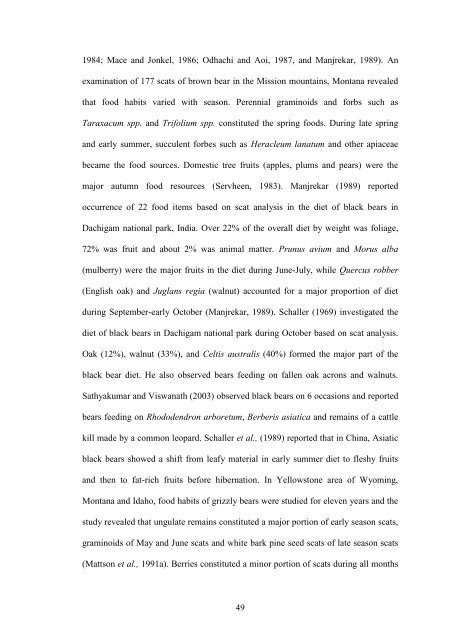Certificate - Etheses - Saurashtra University
Certificate - Etheses - Saurashtra University
Certificate - Etheses - Saurashtra University
Create successful ePaper yourself
Turn your PDF publications into a flip-book with our unique Google optimized e-Paper software.
1984; Mace and Jonkel, 1986; Odhachi and Aoi, 1987, and Manjrekar, 1989). An<br />
examination of 177 scats of brown bear in the Mission mountains, Montana revealed<br />
that food habits varied with season. Perennial graminoids and forbs such as<br />
Taraxacum spp. and Trifolium spp. constituted the spring foods. During late spring<br />
and early summer, succulent forbes such as Heracleum lanatum and other apiaceae<br />
became the food sources. Domestic tree fruits (apples, plums and pears) were the<br />
major autumn food resources (Servheen, 1983). Manjrekar (1989) reported<br />
occurrence of 22 food items based on scat analysis in the diet of black bears in<br />
Dachigam national park, India. Over 22% of the overall diet by weight was foliage,<br />
72% was fruit and about 2% was animal matter. Prunus avium and Morus alba<br />
(mulberry) were the major fruits in the diet during June-July, while Quercus robber<br />
(English oak) and Juglans regia (walnut) accounted for a major proportion of diet<br />
during September-early October (Manjrekar, 1989). Schaller (1969) investigated the<br />
diet of black bears in Dachigam national park during October based on scat analysis.<br />
Oak (12%), walnut (33%), and Celtis australis (40%) formed the major part of the<br />
black bear diet. He also observed bears feeding on fallen oak acrons and walnuts.<br />
Sathyakumar and Viswanath (2003) observed black bears on 6 occasions and reported<br />
bears feeding on Rhododendron arboretum, Berberis asiatica and remains of a cattle<br />
kill made by a common leopard. Schaller et al., (1989) reported that in China, Asiatic<br />
black bears showed a shift from leafy material in early summer diet to fleshy fruits<br />
and then to fat-rich fruits before hibernation. In Yellowstone area of Wyoming,<br />
Montana and Idaho, food habits of grizzly bears were studied for eleven years and the<br />
study revealed that ungulate remains constituted a major portion of early season scats,<br />
graminoids of May and June scats and white bark pine seed scats of late season scats<br />
(Mattson et al., 1991a). Berries constituted a minor portion of scats during all months<br />
49

















